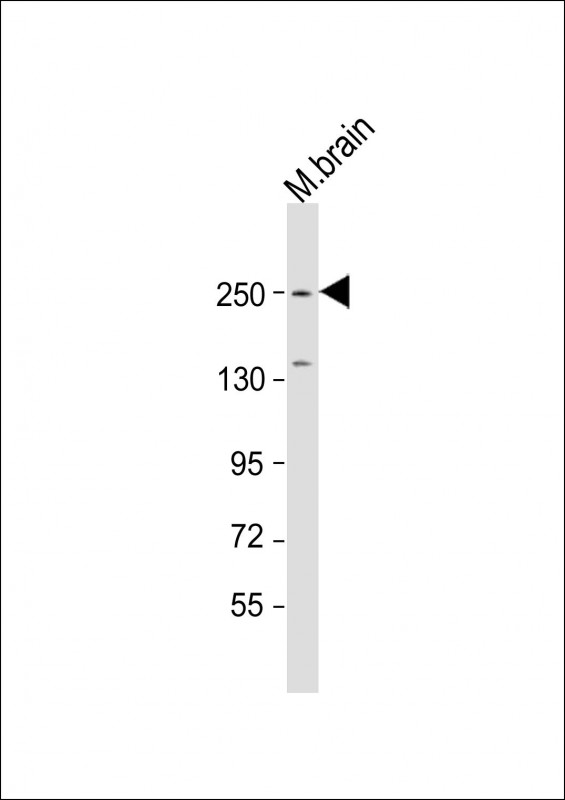SPTBN1 Antibody (C-Term)
Purified Rabbit Polyclonal Antibody (Pab)
- SPECIFICATION
- CITATIONS
- PROTOCOLS
- BACKGROUND

Application
| WB, E |
|---|---|
| Primary Accession | Q62261 |
| Other Accession | Q01082 |
| Reactivity | Mouse |
| Predicted | Human |
| Host | Rabbit |
| Clonality | polyclonal |
| Isotype | Rabbit IgG |
| Calculated MW | 274223 Da |
| Gene ID | 20742 |
|---|---|
| Other Names | Spectrin beta chain, non-erythrocytic 1, Beta-II spectrin, Fodrin beta chain, Spectrin, non-erythroid beta chain 1, SPTBN1, SPTB2 |
| Target/Specificity | This SPTBN1 antibody is generated from a rabbit immunized with a KLH conjugated synthetic peptide between 2063-2097 amino acids from mouse SPTBN1. |
| Dilution | WB~~1:2000 E~~Use at an assay dependent concentration. |
| Format | Purified polyclonal antibody supplied in PBS with 0.09% (W/V) sodium azide. This antibody is purified through a protein A column, followed by peptide affinity purification. |
| Storage | Maintain refrigerated at 2-8°C for up to 2 weeks. For long term storage store at -20°C in small aliquots to prevent freeze-thaw cycles. |
| Precautions | SPTBN1 Antibody (C-Term) is for research use only and not for use in diagnostic or therapeutic procedures. |
| Name | Sptbn1 |
|---|---|
| Synonyms | Elf, Spnb-2, Spnb2, Sptb2 |
| Function | Fodrin, which seems to be involved in secretion, interacts with calmodulin in a calcium-dependent manner and is thus candidate for the calcium-dependent movement of the cytoskeleton at the membrane. Plays a critical role in central nervous system development and function. |
| Cellular Location | Cytoplasm, cytoskeleton. Endomembrane system. Cytoplasm, myofibril, sarcomere, M line. Cytoplasm, cytosol {ECO:0000250|UniProtKB:Q01082}. Cell membrane {ECO:0000250|UniProtKB:Q01082}. Note=Colocalizes with ANK2 in a distinct intracellular compartment of neonatal cardiomyocytes |
| Tissue Location | Isoform 2 is present in brain, heart, kidney and liver (at protein level). |

Thousands of laboratories across the world have published research that depended on the performance of antibodies from Abcepta to advance their research. Check out links to articles that cite our products in major peer-reviewed journals, organized by research category.
info@abcepta.com, and receive a free "I Love Antibodies" mug.
Provided below are standard protocols that you may find useful for product applications.
Background
Fodrin, which seems to be involved in secretion, interacts with calmodulin in a calcium-dependent manner and is thus candidate for the calcium-dependent movement of the cytoskeleton at the membrane.
References
Hu R.J.,et al.J. Biol. Chem. 267:18715-18722(1992).
Chen Y.,et al.J. Mol. Neurosci. 17:59-70(2001).
Totoki Y.,et al.Submitted (MAR-2005) to the EMBL/GenBank/DDBJ databases.
Hillier L.W.,et al.Nature 434:724-731(2005).
Mural R.J.,et al.Submitted (SEP-2005) to the EMBL/GenBank/DDBJ databases.
If you have used an Abcepta product and would like to share how it has performed, please click on the "Submit Review" button and provide the requested information. Our staff will examine and post your review and contact you if needed.
If you have any additional inquiries please email technical services at tech@abcepta.com.













 Foundational characteristics of cancer include proliferation, angiogenesis, migration, evasion of apoptosis, and cellular immortality. Find key markers for these cellular processes and antibodies to detect them.
Foundational characteristics of cancer include proliferation, angiogenesis, migration, evasion of apoptosis, and cellular immortality. Find key markers for these cellular processes and antibodies to detect them. The SUMOplot™ Analysis Program predicts and scores sumoylation sites in your protein. SUMOylation is a post-translational modification involved in various cellular processes, such as nuclear-cytosolic transport, transcriptional regulation, apoptosis, protein stability, response to stress, and progression through the cell cycle.
The SUMOplot™ Analysis Program predicts and scores sumoylation sites in your protein. SUMOylation is a post-translational modification involved in various cellular processes, such as nuclear-cytosolic transport, transcriptional regulation, apoptosis, protein stability, response to stress, and progression through the cell cycle. The Autophagy Receptor Motif Plotter predicts and scores autophagy receptor binding sites in your protein. Identifying proteins connected to this pathway is critical to understanding the role of autophagy in physiological as well as pathological processes such as development, differentiation, neurodegenerative diseases, stress, infection, and cancer.
The Autophagy Receptor Motif Plotter predicts and scores autophagy receptor binding sites in your protein. Identifying proteins connected to this pathway is critical to understanding the role of autophagy in physiological as well as pathological processes such as development, differentiation, neurodegenerative diseases, stress, infection, and cancer.


